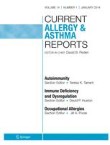
Abstract
Purpose of Review
Allergic rhinitis (AR) is a chronic inflammatory immunoglobulin (Ig) E-mediated disease of the nasal mucosa that can be triggered by the inhalation of seasonal or perennial allergens. Typical symptoms include sneezing, rhinorrhea, nasal itching, nasal congestion and symptoms of allergic conjunctivitis. AR affects a quarter of the population in the United States of America and Europe.
Recent Findings
AR has been shown to reduce work productivity in 36–59% of the patients with 20% reporting deteriorated job attendance. Moreover, 42% of children with AR report reduced at-school productivity and lower grades. Most importantly, AR impacts the patient's quality of life, due to sleep deprivation. However, a proportion of patients fails to respond to conventional medication and opts for the allergen immunotherapy (AIT), which currently is the only disease-modifying therapeutic option. AIT can be administered by either subcutaneous (SCIT) or sublingual (SLIT) route. Both routes of administration are safe, effective, and can lead to tolerance lasting years after treatment cessation. Both innate and adaptive immune responses that contribute to allergic inflammation are suppressed by AIT. Innate responses are ameliorated by reducing local mast cell, basophil, eosinophil, and circulating group 2 innate lymphoid cell frequencies which is accompanied by decreased b asophil sensitivity. Induction of allergen-specific blocking antibodies, immunosuppressive cytokines, and regulatory T and B cell phenotypes are key pro-tolerogenic adaptive immune responses.
Conclusion
A comprehensive understanding of these mechanisms is necessary for optimal selection of AIT-responsive patients and monitoring treatment efficacy. Moreover, it could inspire novel and more efficient AIT approaches.



Δεν υπάρχουν σχόλια:
Δημοσίευση σχολίου
Σημείωση: Μόνο ένα μέλος αυτού του ιστολογίου μπορεί να αναρτήσει σχόλιο.